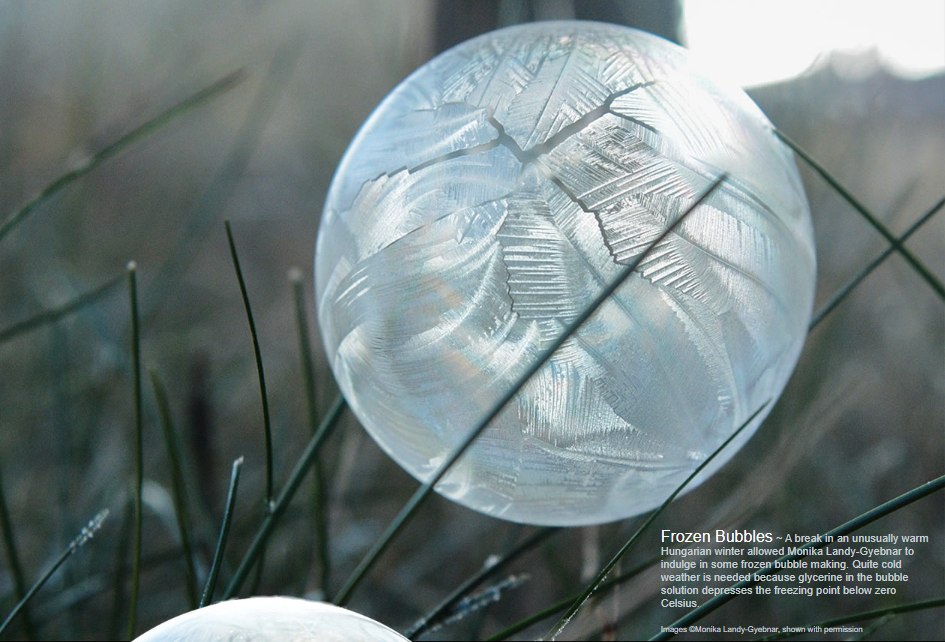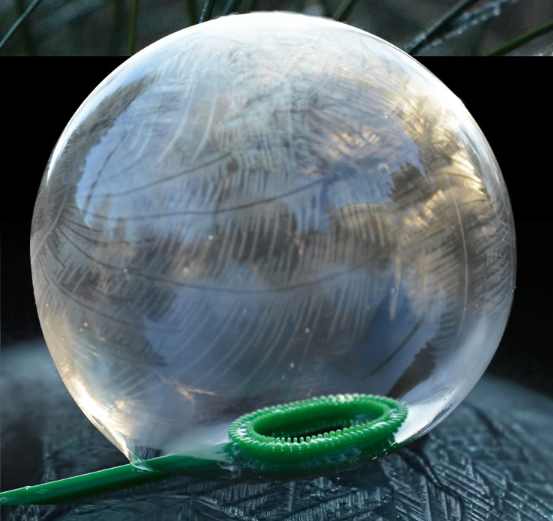Frozen Bubbles - OPOD
Frozen Bubbles: A Captivating Phenomenon
The beauty of frozen bubbles has captivated people around the world, and Hungary is no exception. Monika Landy-Gyebnar took advantage of an unusually warm winter break to indulge in the creation of these enchanting ice formations. While cold weather is a prerequisite for freezing bubbles, the addition of glycerine to the bubble solution lowers the freezing point below zero Celsius, allowing for their formation.
Landy-Gyebnar's process involved using a simple mixture of dishwasher liquid, glycerine, and water. When the temperature was at its coldest, the bubbles took approximately 3-4 minutes to freeze. However, as the temperature rose, the freezing process became significantly slower. Patience was key, as many bubbles popped before they could fully freeze. Interestingly, Landy-Gyebnar discovered that blowing bubbles on a snow surface expedited the freezing process. Unfortunately, she did not have access to snow at the time, so she experimented with various surfaces, finding success with both grass and the lid of a waste bin.
In colder regions such as Canada and Finland, where temperatures reached as low as -18°C, frozen bubble enthusiasts have documented unique patterns on their bubbles. These patterns, known as ferns, differ from those observed in less cold weather conditions. In extremely frigid temperatures below -20°C, the ferns become smaller and more uniformly shaped, often resembling small four-point star formations. While it remains unclear whether the pattern difference is due to variations in bubble mixture or the type of solution used, it is intriguing to note that similar patterns emerge despite different locations and bubble blowers.
To understand the science behind frozen bubbles, we must delve into the process of ice formation. Water molecules require a nucleus on which to initiate the phase change to ice. This nucleus can be in the form of dust particles, proteins from snow machines, bacteria, or other microscopic particles. Once a tiny ice crystal forms, it spreads across the thin bubble sheet. The growth of ice is most rapid along the edges of the crystal, resulting in dendritic, treelike patterns that follow the hexagonal crystal directions. These intricate yet symmetrical shapes are reminiscent of snowflakes, which are formed through a similar process.
One intriguing question arises: would a slightly dusty bubble mixture freeze faster? The presence of dust particles or other impurities in the bubble solution could potentially provide more nuclei for ice formation, accelerating the freezing process. However, further research is required to determine the precise impact of dust on the freezing rate of bubbles.
It is worth noting that at extremely low temperatures, spontaneous nucleation occurs, meaning that no nuclei are required for ice formation. In such conditions, ice crystals can form spontaneously without the presence of any external particles. This phenomenon adds to the complexity and diversity of frozen bubble patterns observed in different temperature ranges.
The allure of frozen bubbles continues to inspire awe and wonder among both amateur and professional photographers. As we explore this captivating atmospheric optics phenomenon, we gain a deeper appreciation for the intricate beauty that can emerge from the simple act of blowing bubbles on a frosty day.

Frozen Bubbles ~ A break in an unusually warm Hungarian winter allowed Monika Landy-Gyebnar to indulge in some frozen bubble making. Quite cold weather is needed because glycerine in the bubble solution depresses the freezing point below zero Celsius.
Images ©Monika Landy-Gyebnar, shown with permission

"I used dishwasher liquid (one for hand washing dishes), some glycerine and water. Nothing special.
The bubbles took about 3-4 minutes to freeze when it was coldest outside. Later as the temperature rose the freezing became much slower. Of course it took a lot of patience as many bubbles popped before freezing.
Many people have tried it in Hungary during the cold days and in the east where it was much colder (even -18°C was reached) it was easier. One girl blew the bubbles on snow surface and that made it freeze really quickly. I had no snow when it was cold, and tried many surfaces, both the grass and the lid of our waste bin worked well.
I’ve seen a lot of frozen bubble pics from really cold locations (Canada, Finland etc.) and the fern pattern on those bubbles differs a lot from our results in less cold weather. The colder it was the ferns became smaller and more even shaped (small 4-point star shapes were common). Of course I don't know if the mixture was similar or the type they used was the cause of the pattern difference, but in temperatures below -20°C the patterns were very similar despite very different locations and bubble blowers."
Water molecules need a nucleus. – dust, a snow machine protein, bacteria or other particles on which to start the phase change to ice. Once a tiny crystal forms, it spreads across the thin bubble sheet. Growth is fastest at crystal edges. It is dendritic, treelike, along the hexagonal crystal directions to give the characteristic patterns. The complex but overall symmetric shapes of snowflakes are similarly produced.
.Thought, would slightly dusty bubble mixture start to freeze faster?
..At very low temperatures no nuclei are needed - there is spontaneous nucleation.
Note: this article has been automatically converted from the old site and may not appear as intended. You can find the original article here.
Reference Atmospheric Optics
If you use any of the definitions, information, or data presented on Atmospheric Optics, please copy the link or reference below to properly credit us as the reference source. Thank you!
-
<a href="https://atoptics.co.uk/blog/frozen-bubbles-opod/">Frozen Bubbles - OPOD</a>
-
"Frozen Bubbles - OPOD". Atmospheric Optics. Accessed on December 22, 2024. https://atoptics.co.uk/blog/frozen-bubbles-opod/.
-
"Frozen Bubbles - OPOD". Atmospheric Optics, https://atoptics.co.uk/blog/frozen-bubbles-opod/. Accessed 22 December, 2024
-
Frozen Bubbles - OPOD. Atmospheric Optics. Retrieved from https://atoptics.co.uk/blog/frozen-bubbles-opod/.